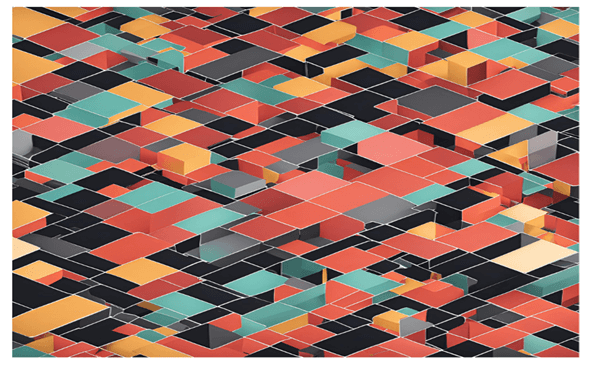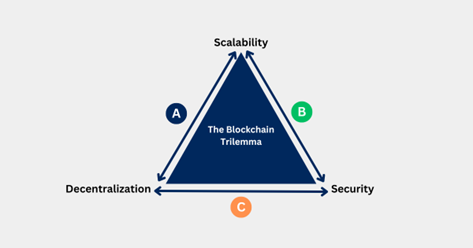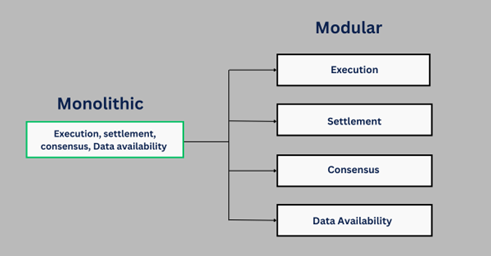Doubling Down on Modular Blockchains
Published Date: 19 Sep 2024
Breaking The Monolith

The concept of a "modular blockchain" has become a popular narrative around scalability and blockchain infrastructure. Over the years, Blockchain researchers have been working hard on the challenge of creating an optimal scalable and secure system. This led to the discovery of the concept that a single blockchain doesn't have to handle everything by itself, this idea has evolved into modular blockchains.
This guide gives a basic introduction to the concept of modular blockchains, you can call it an “oversimplified guide”. But before delving into the nitty gritty of modular blockchains, we’ll first examine the current landscape of blockchain architectures.
Monolithic Blockchains
Early blockchain design relied on monolithic architectures, where a single chain shouldered all core functionalities: transaction execution, consensus, data availability, and settlement. This one-size-fits-all approach, exemplified by Ethereum, proved increasingly challenging as user bases grew, leading to bottlenecks and high transaction fees.
- Execution — executing transactions
- Consensus— Ordering transactions,
- Data Availability — Ensuring the availability of block data.
- Settlement — Execution of rollups is verified and disputes are resolved
The allure of a one-size-fits-all blockchain, exemplified by Ethereum's early design, gradually gave way to the recognition of its inherent limitations. As the Ethereum user base swelled, its single layer struggled to cope, resulting in sluggish transactions and exorbitant fees. This growing strain exposed the need for more nuanced approaches to blockchain architecture.
The scalability trilemma Scaling monolithic blockchains presented the infamous scalability trilemma: a trade-off between decentralization, security, and scalability. As Ryan and David discussed in the Bankless Podcast, these three pillars often exist in a delicate balance, with attempts to improve one potentially affecting the others.

Think of the early blockchain like a single-lane road struggling under the weight of millions of transactions. That's where scaling solutions came in. Imagine building extra lanes alongside the main road, each taking its own chunk of the traffic. That's essentially what sharding does, splitting the blockchain into smaller pieces to process transactions faster.
But what about those quick, everyday transactions? For those, we built side streets – layer 2 blockchains. These handle smaller, simpler transactions off the main chain, keeping the traffic flowing smoothly on both chains. The goal? A blockchain that scales like a superhighway, where millions of users can interact securely and efficiently, without sacrificing that core layer of trust and decentralisation.
Understanding Modular blockchains
The concept of modular blockchains, where distinct functionalities like consensus and execution operate independently, gained traction with the landmark LazyLedger blog post from Celestia Labs.
Understanding what a "modular blockchain" means is like dissecting a Lego set. In traditional blockchains, all the pieces – transactions, consensus, and data storage – are locked together as one massive block. Modular blockchains are like separating those pieces into distinct Lego bricks, each with its own specific function. You can then mix and match them to build different types of chains optimised for specific needs.
The LEGO Metaphor
Have you ever played a LEGO game? If you have, you will grasp the concept of modular blockchains better. Imagine building blocks, not just any blocks, but blocks designed for specific purposes. Some handle data storage, others power transactions, and some ensure everyone agrees on the order of things. Modular blockchains operate like these specialised blocks, decoupling core functions into interconnected layers, each optimised for its unique role.
Picture a blockchain that sheds the burden of being a master of all. Modular blockchains do just that, breaking down tasks like execution and consensus into independent modules. This isn't weakness, it's strength. Each module excels in its specific area, optimising performance and avoiding the bottlenecks of monolithic designs. The result? Systems that scale effortlessly, remain secure, and stay true to the core principles of decentralisation.

For example, you can put the term modular blockchain on rollups, since they specialise in execution, while outsourcing everything else (consensus, data availability, and settlement) to Ethereum as a monolithic entity.
Celestia
Celestia is a modular data availability (DA) network that securely scales with the number of users, making it easy for anyone to launch their blockchain. Celestia's story began in 2019, not with lines of code but with a research paper. Mustafa Al-Bassam, the project's founder, envisioned a novel blockchain architecture: one separate from the limitations of monolithic designs. His paper, "LazyLedger: Towards a Sublinear Verification of Block Data Availability," proposed a groundbreaking concept – separating data availability and consensus from transaction execution.
This seemingly abstract idea soon took form as a project named LazyLedger, a sidechain built on Ethereum that leveraged Al-Bassam's research. In 2021, LazyLedger shed its prototype skin and transformed into Celestia, officially ushering in its own Layer 1 blockchain.
The early days were dedicated to building the core infrastructure – the Byzantine Fault Tolerance (BFT) consensus mechanism, light client technology, and the Inter-Blockchain Communication (IBC) integration. Developers around the world took notice, drawn to Celestia's unique modular approach and its potential to tackle blockchain scalability head-on.
2023 marked a pivotal year for Celestia. In October, the network launched its mainnet, bringing its vision to life. The launch saw the release of the TIA token, used for governance and incentivizing network security. The Celestia ecosystem also began to flourish, with projects like Axelar, Osmosis, and Sienna Network building rollups on top of the platform.
Advantages of Modular Blockchains
Improved Security
Modularization allows for compartmentalization, where vulnerabilities in one module can be isolated and contained, preventing them from cascading through the entire system. This enhances overall security and protects applications from bugs and exploits. Additionally, specialised security modules can be deployed to provide focused protection for specific needs.
Scalability
Modular blockchains bring extra scalability, since the core idea is to split functions across multiple chains. As such, the resources are distributed into more specialised units, which leads to better efficiency. Through this, the overall throughput of the blockchain is increased leading to better scalability, yet the other two aspects, namely decentralisation and security, are not compromised.
Flexibility
The modular approach allows greater flexibility in designing custom blockchain networks that can handle a wide range of use cases. The modular approach fosters rapid innovation as developers can focus on building novel applications without reinventing the wheel for core functionalities.
The Future Ahead
Modular blockchains are gaining massive traction around the blockchain infrastructures, with each protocol pushing the envelope, improving scalability and flexibility. We’ve certainly come a long way from the monolithic, “one-size-fits-all” blockchain era. Modular blockchains represent a paradigm shift, moving away from monolithic limitations and unlocking a future of flexible, scalable, and secure blockchain applications. As the technology matures and standardization improves, we can expect modularity to become the default design pattern for building robust and adaptable decentralized systems.
Remember, the benefits of modular blockchains are multifaceted, going beyond just technical advantages. They pave the way for a more dynamic and collaborative blockchain ecosystem, empowering developers and users to build the future of decentralized applications with limitless potential.
Maximize your value and knowledge with our 5 Reports-in-1 Bundle - over 40% off!
Our analysts are ready to help you immediately.
